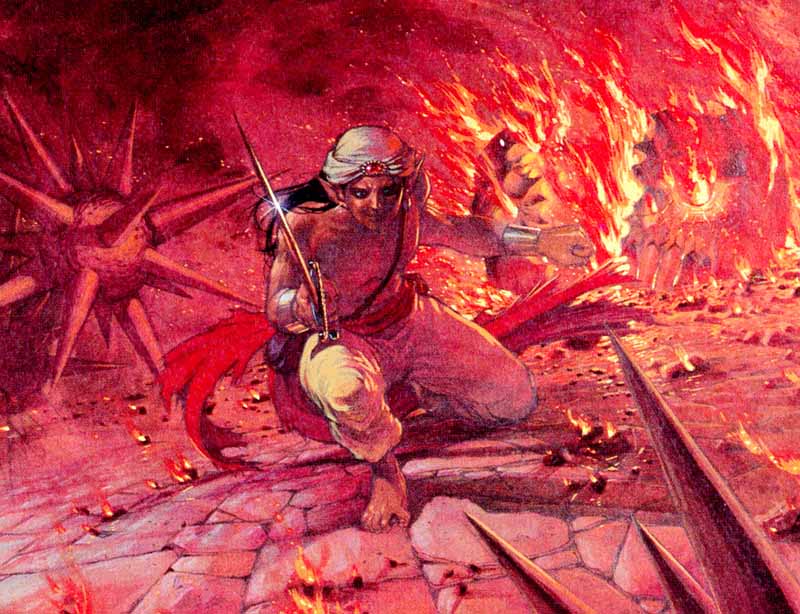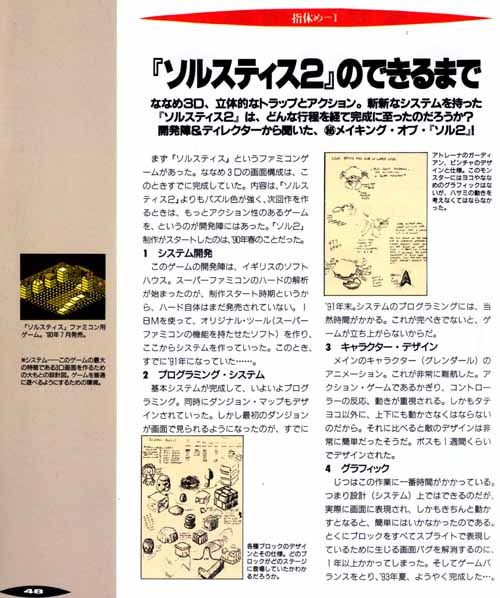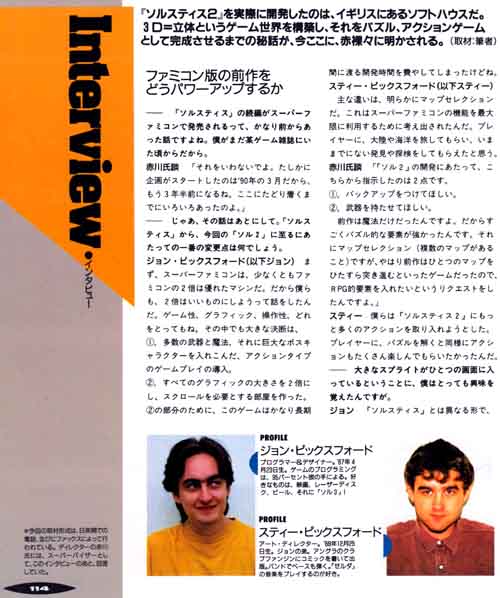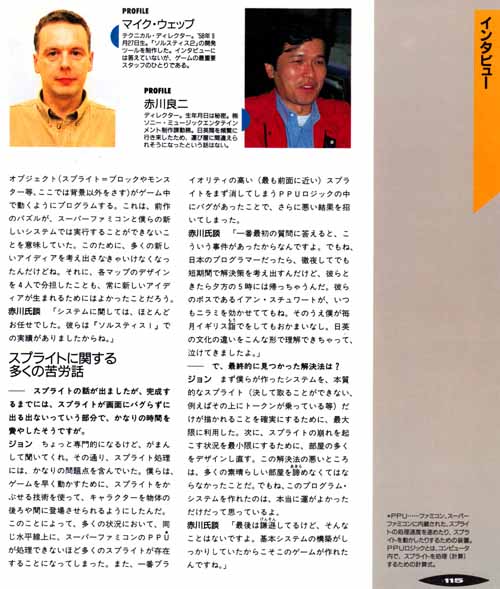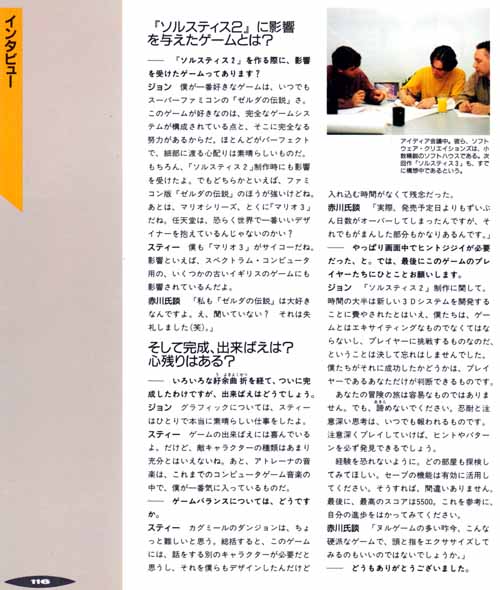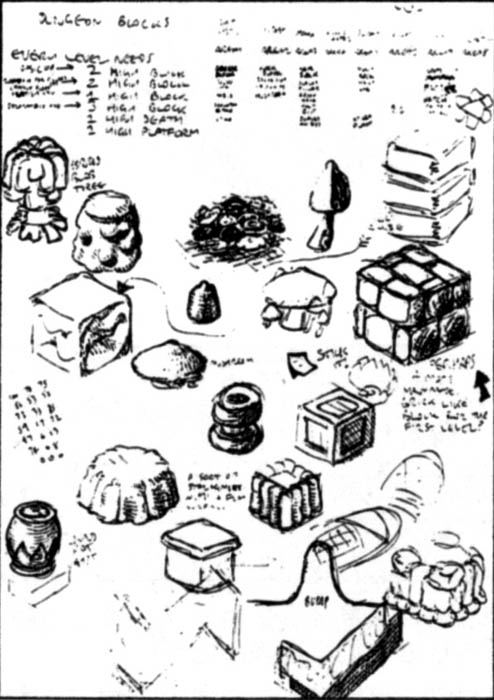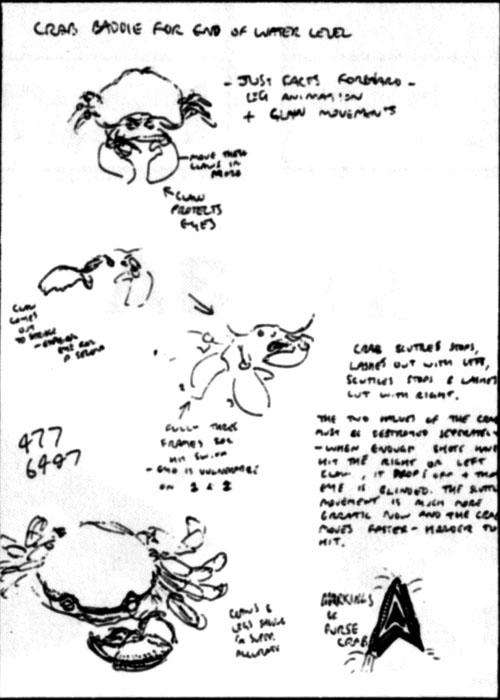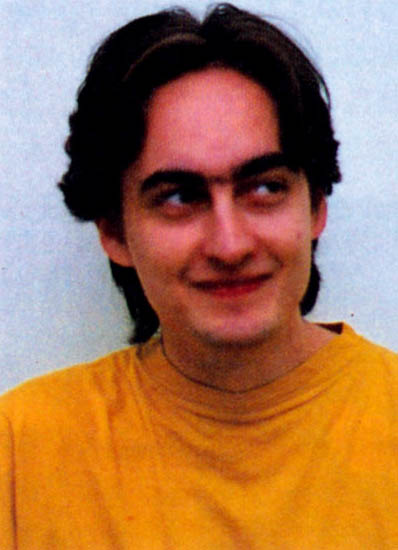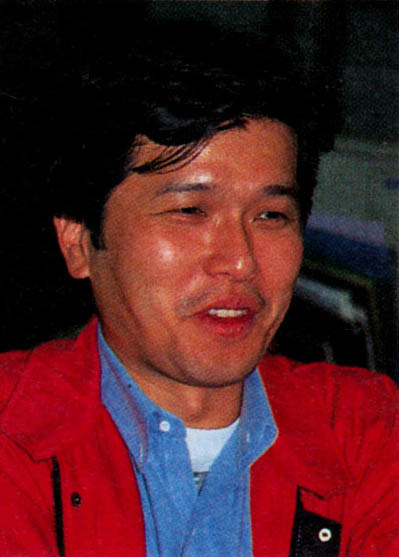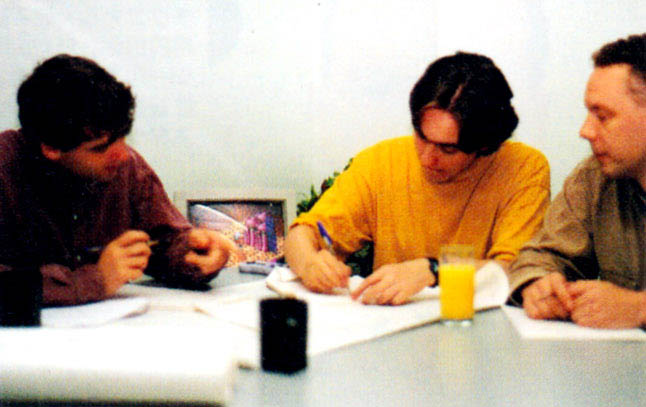| What are the improvements over
the Family Computer version?
|
| Rumours had circulated even before
the release of the Super Famicom that a sequel to Solstice was being
planned. I was still a writer for a certain game magazine then. |
| Ryoji Akagawa |
Don't remind me! Indeed, the project was begun
in March 1990, so that makes it already 3 1/2 years ago. It was
a long road from there to where we are now. |
| Okay, we'll get into that later.
What is the biggest difference that Sol 2 has over Solstice? |
| John Pickford |
First, the Super Famicom is a machine which
has at least twice the power of the Family Computer. So, I also
wanted to make a game that's twice as good, no matter what you consider:
game design, graphics, play control, anything. The biggest decisions
we made were:
1) Introduction of action-style gameplay through multiple weapons,
magic, and huge bosses; and 2) The size of all graphics was doubled
and thus created rooms which needed to be scrolled around. As a
result of the latter, the development time we spent on this game
grew considerably. |
| Ste Pickford |
The main difference is obviously the overworld
map selection. We implemented this in order to make the most of the
capabilities of the Super Famicom. The player is made to travel over
continents and oceans, which lends a sense of discovery and exploration
not found in the previous game. |
| Akagawa |
I made two requests when development began on Sol
2:
1) I want you to add battery backup.
2) I want you to provide weapons in the game.
The previous game had only magic to use. Therefore, the game had an
incredibly strong puzzle element to it. The first game also had only
a single map which required focus for the player to get through [in
a single sitting!], so the addition of multiple maps [in the new game]
made the game more RPG-like, as I had wanted. |
| Ste |
I tried to bring in much more action to Solstice
2. I wanted the player to have fun solving puzzles as well as
enjoy lots of action. |
| I remember how excited I was when
a large sprite appeared taking up the whole screen! |
| John |
Solstice was a different type of game, such
that objects (AKA sprites: blocks, monsters, etc. overlaid on the
background) are all programmed to be movable by the player. [The action
element of Sol 2] meant that the puzzles of the previous game
could not be used in the same way in our new game engine on the Super
Famicom. So we of course had to come up with new and different ideas.
It was probably, then, a good idea that we shared the design of each
map among four people, guaranteeing fresh ideas each time. |
| Akagawa |
I mostly left the engine up to them since they
had established a good track record in Solstice 1.
|
| Many headaches over sprites
|
| Speaking of sprites, I hear it
took you quite a long time to eliminate intermittent on-screen sprite-related
bugs before the game was finished. |
| John |
This will get a bit technical, so bear with
me. As you said, sprites became a huge problem. In order to get
the game moving at a good speed, I used sprites to enable objects
to overlap on-screen, appearing behind a part of the background,
or in-between two different objects. This created too many sprites
for the PPU* of the Super Famicom to
process on the same scanline. Even worse, a bug in the PPU logic
caused sprites with the highest priority (closest to the front of
the screen) to disappear. |
| Akagawa |
To answer your first question, yes, there were
problems like these. But... if they had been Japanese programmers,
they would have stayed up all night trying to devise a solution.
Instead, these guys went home at 5:00pm anyway, even as their boss,
Ian Stewart, was glaring at them. Even my going to Britain on monthly
visits didn't faze them. I got an understanding of the differences
between Japanese and English culture in such a way, and it drove
me to tears. |
| So, finally, what type of solution
did you come up with? |
| John |
First, we made our engine draw only the most
essential sprites (ones that cannot be blanked out, such as a sprite
that a token is resting on.) Second, in order to minimize flicker,
we had to redesign many rooms. The downside to doing this was that
so many wonderful rooms had to be eliminated too. Still, I consider
ourselves truly lucky that we were able to make such a game engine
in the first place. |
| Akagawa |
He's modest until the end, but it's not true.
It is precisely because his basic engine is so solidly-built
that making the game became possible.
|
| What games influenced Solstice
2?
|
| While making Solstice 2, are
there any games that influenced you? |
| John |
My favourite game will always be Zelda III
on the Super Famicom. What I like about it is how much effort was
spent on it to make a perfect game. It's essentially perfect; the
attention to detail is just wonderful. Of course Solstice 2
was influenced by it. But strictly speaking, it's the Family Computer
version, The Legend of Zelda, which had the stronger influence
on me. There's the Mario series, too, especially SMB3.
I mean, Nintendo have simply the best designers in the world, haven't
they? |
| Ste |
I also think Mario 3 is the best. Speaking
of influences, there are several British-made games that did, on
the old Spectrum computer. |
| Akagawa |
The Legend of Zelda is also the best
for me. Oh, you weren't asking? Sorry... (laughs) |
| With the game completed, what
are you proud of? What do you regret?
|
| Although there were many complications
along the way, the game has finally been finished. What are you most
proud of? |
| John |
The graphics. Ste did, all by himself, some truly
fantastic work. |
| Ste |
I am happy with the job we did. However, I can't
help but think that there were not enough enemy types. Anyway, the
music in Atlena, of all computer game music up to this point, is my
absolute favourite. |
| What do you think of the difficulty
curve? |
| Ste |
I think that the dungeon in Quagmire is slightly
too difficult. Overall, I think the game needed another character
that talked to you. We did actually design this character, but unfortunately
there was no time to add him to the game. |
| Akagawa |
In fact, we went past the deadline and missed
the scheduled release by many days... but that was just one of the
rather numerous things that I had to put up with. |
| Indeed, a wise sage to give you
hints was needed in the game. Okay, any final things you want to
say to the players out there? |
| John |
Relating to the development of Solstice 2,
we spent a majority of the time creating a new 3-D engine, but we
never forgot that the game needed to be exciting and a good challenge
to the player. Only you, the player, can judge whether we succeeded
in this.
Your voyages through this adventure will not be easy, but please
don't give up. Patience and careful thinking will always be rewarded.
If you pay attention while playing, you will surely find hints and
solutions.
Do not be afraid to experiment. I want you to try to explore every
room. Make effective use of the save feature, as this reduces the
risks of any mistakes. Finally, the highest score is 5500. Use this
score as a reference for gauging your success. |
| Akagawa |
In an age full of limp games, such a demanding
test of your reflexes and your mind must be a good thing, right? |
| Thank you very much. |
